Revisiting Ensor and Belgium’s art museums-Part 4

In this final report on my recent visits to several Belgian museums, I turn my attention to some of the larger art museums in Oostende, Brussels, and Antwerp (although I already discussed the Ensor year exhibitions at the Oostende and Antwerp museums in the first part).
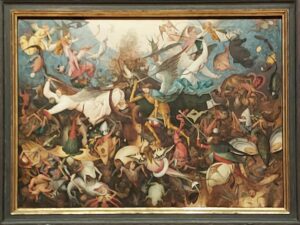
The Mu.ZEE in Oostende exhibits and collects modern and contemporary Belgian art, with a focus on artists who lived in that city, including the famous James Ensor and his contemporary Léon Spilliaert. The name of the museum is a contraction of the words “museum” and “zee”, the Dutch word for “sea”, which actively situates the museum in its environment. There are several photo-collages, in the permanent galleries, by Sammy Baloji (b1978), who was born in the Democratic Republic of Congo, and Otobong Nkanga (b1974), a Nigeria-born artist whose work had also been exhibited at the Old St Jan Hospital in Bruges. So, there is some effort to open the conversation by including artists who challenge how “Belgianness” has been conventionally construed. Little or nothing is done, however, to interrogate how their works relate, or form a critical counterpoint to other works on view.
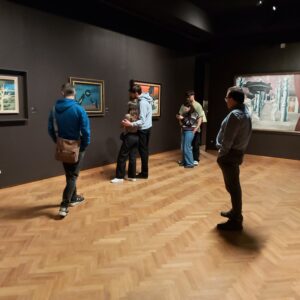
Mu.ZEE is housed in an old cooperative department store from the 1950s. In terms of their size and spatial organization, department stores can easily be repurposed as museum spaces, as was, for instance, also done for the National Gallery of Jamaica in downtown Kingston. The Mu.ZEE building looks a bit dated and worn, however, and will soon be closed for a major renovation. Hopefully, the “mid-century modern” elements in the architecture will be retained, as they are part of the building’s history and distinctiveness.
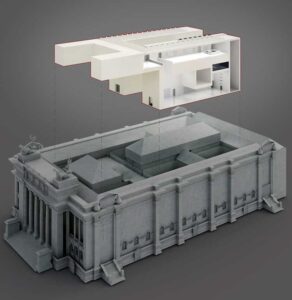
In Brussels, I went to the Old Masters section of the Royal Museum of Fine Arts and the adjoining René Magritte Museum, which opened its doors in 2009. Both museums are in the Kunstberg (Art Mountain) district, near the Royal Palace, that has a high concentration of museums, galleries, and cultural centres. The Old Masters Museum has a vast collection with an overview from early Flemish painting to nineteenth century academic painting. The gallery with paintings by Pieter Bruegel the Elder and his son Pieter Bruegel the Younger is probably its main attraction (and one of the reasons I decided to visit there, as Bruegel the Elder is one of my favourite Flemish artists).
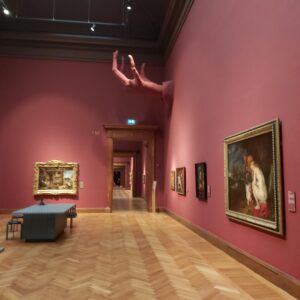
The Old Masters Museum offers a predictably conservative museum environment. No effort is made to invite visitors to look at things differently and there is no sense that any major changes are needed or demanded. There may simply be less pressure to change than with certain other museums. With its near-exclusive focus on Belgian art history, its collection not generally subject to restitution demands and not being a museum of modern and contemporary art, demands for inclusion and equitable representation are less acutely posed. As was also evident at Mu.ZEE, it is clearly assumed that the viewer is familiar and comfortable with what is on display, informed by a strong sense of cultural identification, despite Belgium’s, and Brussel’s, recent demographic and cultural changes. This conservatism does not seem to affect visitorship, however, as the galleries were quite crowded with a diverse mix of school groups and individual visitors, although I went on an ordinary weekday.
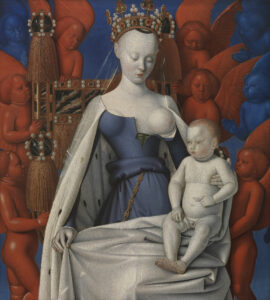
The surrealist painter René Magritte (1898-1967) is one of Belgium’s most iconic and influential modern artists. Magritte’s work, which places the familiar and the ordinary in extraordinary, provocative juxtapositions, can be seen in many museums in Belgium and internationally and it is popular with broad audiences. The Magritte Museum, which seems to be even more popular than its venerable neighbour, is a veritable shrine to the artist’s life and work. The galleries take the viewer through a detailed, chronological overview of Magritte’s work, starting with the early years on the top floor and descending to the final years of his life and career. Ample contextual information is provided, including a detailed illustrated timeline in each gallery area along with documentary material, and there are quotes by Magritte on all the walls that help to elucidate his artistic philosophy.
I enjoyed viewing the museum’s large collection of Magritte’s work but was disappointed at the over-designed installation, with claustrophobic dark walls and boutique lighting that was reflected uncomfortably on the canvases and works behind glass. It is one thing to under-contextualize, as in the Old Master’s section, but it is quite another to go overboard with contextualization and exhibition design. The works of art also need to be able to speak for themselves. A more selective approach to Magritte’s work, with more light and breathing space, technically appropriate gallery lighting, and fewer of his quotes on the wall, would probably have done more justice to his work.
The design flaws at the Magritte Museum may result from trying to convert the large palatial spaces of the nineteenth century townhouse in which it is housed into something more intimate and engaging. The adjoining Old Masters Museum is in an even larger building. This “beaux arts” building style, of which the Royal Museum of Fine Art in Antwerp is another example, was popular in the nineteenth century to showcase art in the grand academic tradition, such as history and mythological paintings, and to convey the cultural and social hierarchies that were implied in those artistic conceptions. Such buildings were designed to impress, as “high art temples”, and not to welcome and reassure uninitiated visitors. With their enormous gallery spaces and high ceilings, often more than twenty metres high, they are also not very suitable for smaller art works that require a more intimate viewing context. At the Old Masters Museum, there are special structures within the large mezzanine areas to accommodate smaller works, such as the Early Flemish Collection, but they now look quite dated and out of place in the museums grandiose architectural setting.
More imaginative solutions are evident at the Royal Museum of Fine Art in Antwerp, which features Old Masters along with modern and contemporary art, with a focus on Antwerp-based artists such as Peter Paul Rubens (1577-1640) and Jacob Jordaens (1593-1678). As I noted in the first part of this series, the museum also has a substantial James Ensor collection. One of the best-known works in the museum collection is the hauntingly surreal Virgin and Child Surrounded by Angels (c1452) by Jean Fouquet (c1420-1481), a French contemporary of the early Flemish painters.
The Antwerp Museum reopened in 2022 after an eleven year-long renovation by the Dutch architectural firm KAAN architects. A new structure to house the modern and contemporary art exhibits was literally inserted into the large, unwieldy open spaces of the original building. While technically impressive, the new section has a sterile, minimalist “white cube” aesthetic which is just as predictable, and limiting, as the old beaux arts style. What impressed me far more is what was done in the Old Master galleries, where the spatial volumes and beaux arts ambience were left intact, but animated with provocative interventions that brought the building to life. In one gallery, for instance, a gigantic hand projected from the wall moved intermittently, while in another there was an immersive video installation with animated details from some of the Museum’s best-known works (both were uncredited). This added a fantastic, playful quality to the previously dull and pompous beaux arts spaces, in ways that seemed to build on the surreal qualities in well-known collection works such as the earlier-mentioned Fouquet painting. The exterior of the museum, unfortunately, remains as gigantic and forbidding as it has always been, without even a hint of the radical transformations inside.
The Belgian museums I visited are locally focused and preoccupied with promoting local and national pride in what is indeed a significant and distinctive artistic and cultural heritage. Some seem oblivious to the rapidly changing social and cultural environment and simply do what they have always done, albeit without much contention resulting. Others are making at least some efforts to change the conversation and to become more engaging and inclusive. These changes are commendable but often appear tokenish, stopping short of the more fundamentally critical, self-reflexive, and transformative approach to museum curation that one would like to see.
The inclusion efforts also seem selective and one-sided. There are now obvious efforts to feature artists of African descent, but I did not see any comparable attention paid to artists of Arab descent, although Belgium now has a significant Muslim population (7.6 % of the population and mostly with roots in the Middle East and North Africa), which is the source of far more acute social, political, and cultural tensions than the African presence in the country. Perhaps that is too much of a “hot potato” for notoriously risk-averse museums to handle. Ironically, despite the horrendous history and legacies of the Belgian Congo and Belgium’s broader role in Central Africa, focusing on artists of African descent may be a “safer” virtue-signaling choice in the present moment. Obviously, there is a lot of work left to be done.
Dr Veerle Poupeye is an art historian specialized in art from the Caribbean. She works as an independent curator, writer, researcher, and cultural consultant. The second, revised and expanded edition of her best-known book “Caribbean Art” was recently published in the World of Art series of Thames and Hudson. Her personal blog can be found at veerlepoupeye.com.






